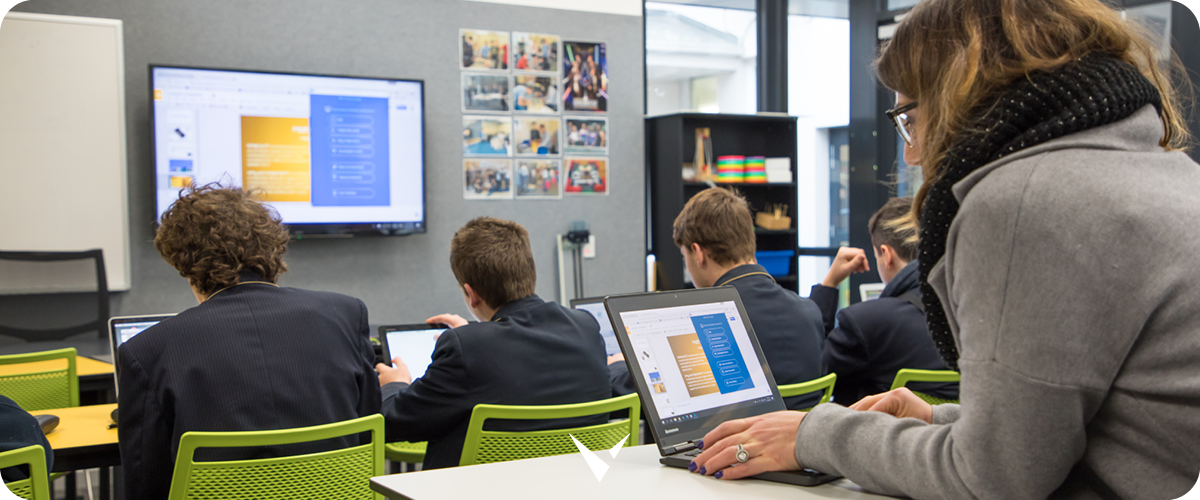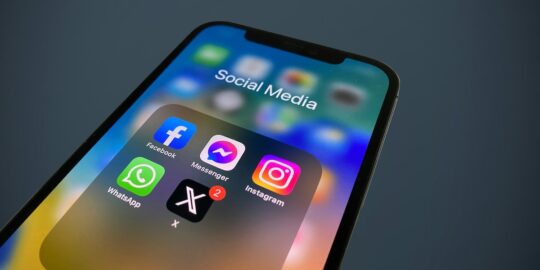
The education sector has been one of the top beneficiaries of the advancement in display technologies.
A 2018 research study on the impact of online and technology-centric learning found that the use of new technologies in the classroom has contributed to increased student satisfaction, motivation to learn, and academic performance.
Screen mirroring is one of the most impactful technologies for the traditional classroom. The digital shift in education is rapidly transforming the classroom and improving the overall learning experience. Screen mirroring works by connecting the teacher’s device to a display within the same wireless network.
Modern school districts and higher education institutions are increasingly investing in new technology to make teaching more innovative and engaging. Considering how tech-savvy the current generation of learners is, it is only a matter of time before these technologies are a must-have in every classroom.
What is Screen Mirroring Technology?
Screen mirroring technology is a hardware and software system that allows a teacher to share a device screen with a display wirelessly. The integrated hardware and software solution allows the teacher to send lesson content and media on a tablet, laptop, or smartphone to a larger display such as a media projector, interactive flat panel, or television.
Many modern devices come with built-in protocols that support media mirroring on a separate device. What makes classroom screen mirroring technology unique is that it can support hybrid environments and media types. Teachers can mirror multimedia such as audio, images, and video, web browsers, and software windows with great agility and speed.
Technology is impacting teaching and learning in many ways. Here are seven of the most notable ways screen mirroring technology is revolutionizing the classroom.
Improves Lesson Engagement
Students learn better and retain information for longer when the learning process engages multiple of their senses aside from the teacher’s voice. The traditional lecturing approach to teaching has its downsides, top among them being disengagement. With screen mirroring, teachers can deliver lessons using different mediums including images and videos, audio, and tactile feedback or animated text.
The introduction of screen mirroring technology in the classroom has set the stage for a more engaging learning environment. The technology offers teachers a myriad of ways to present lesson content in ways that will pull the students into the lesson material with less effort.
This technology also sets the teacher free to move around the classroom and attend to students wherever they are in the room. Since the teaching device screen is shared wireless onto a central classroom display or smaller displays organized around the classroom, the teacher can move around the classroom to ensure students are attentive to the screen in front of the class.
Today’s learners are the most tech-savvy in history. According to a study published by Pedagogy in Action, learners today have an easier time engaging with content via the same medium in the class as those they interact with multimedia content outside school.
Enhances Collaboration Between Learners
In the traditional classroom environment, the only way learners can collaborate is by getting into groups or exchanging their books. Educators often have a hard time trying to nurture collaboration because the lecturing approach to teaching is very limiting.
However, a classroom with a large display such as a TV or projector that supports screen mirroring makes it easy for the learners to make group presentations and engage other learners in their groups and the classroom. This technology makes it easy for students to share any of their digital work moment by moment during a lesson.
The best part is that it is not just the teacher device that can be mirrored to the big screen to make collaboration possible. The students may connect to the wireless device, too, but the teacher can preview the student material and approve them to share their work or provide feedback.
In a classroom with screen mirroring, the teacher has complete control over what is shared, who shares it and when. The teacher may demonstrate learner activities on the larger screen to encourage the class to discuss them, provide feedback, and share their own work.
Collaboration between the teacher and learners is critical to imparting knowledge in a way that the learners understand. The teacher can build the trust necessary to encourage collaboration by mirroring their device when teaching and allowing students or groups to mirror their devices to the classroom screen when they need to share or make a presentation. This goes a long way to encourage learners to view performance and lessons from the points of view of other learners without exchanging notebooks.
In group activities, students may take turns reviewing other groups’ work and giving feedback on their assignments. With a centralized screen to highlight each group’s work in turn, the teacher can take charge to bring the classroom to life.
Gamification of Classroom Lessons
According to a report published by McGraw Hill, aside from being disengaging to the learners, the American education system has one major problem: it’s boring. The traditional approach to teaching leaves students struggling to keep focused. They feel under-stimulated and disengaged from the ”lecturing” teachers and are rarely interested in what is going on.
The major cause of boredom, according to the report, is the way the subject matter is presented. Lecturing just isn’t interesting. Many learners get more stimulation outside the classroom by playing games, watching TV and movies, and engaging friends on social media than they do in the classroom.
The introduction of screen mirroring technology in the classroom is a big step toward making lessons more interesting. Teachers can now boost engagement by embedding interactive content such as games, memes, points, timers, leaderboards, polls, and other media into the standard lessons to motivate the learners.
Screen mirroring technology, on its own, cannot revolutionize the classroom experience. However, it gives the teachers an opportunity to gamify learning and keep learners switched on through the lesson.
For instance, the teacher can break down lengthy lessons with a lot of explanations into smaller chunks of mini-lessons such as games, videos, graphic explanations, etc. that the learners can easily digest. Since the content on the teacher’s device is mirrored onto the large screen in front of the classroom, the teacher is in full control over the rate at which the lesson progresses as well as the content presented at all times.
Screen Mirroring Centralizes Teaching in The Classroom
One of the greatest benefits of using screen mirroring technology in the classroom is how easy it puts the teacher in charge of the room. For effective learning in a physical classroom, the teacher must be in charge of content delivery.
Unlike other common classroom technologies, screen mirroring technology centralizes presentation to the teacher’s device. The teacher controls what content is shared. The teacher does not have access to the students’ computers, only what they are allowed to mirror onto the display.
The teacher maintains complete control over the lesson in the classroom and is free to choose which content to load from their device. This is an invaluable feature that merely ”upgrades” the quality of the traditional approach to teaching rather than introducing entirely new elements and content delivery mediums.
Regardless of how ”old-school” the teacher is, it does not take much effort or time to master screen mirroring as long as they have full control over the device they use to teach.
Screen mirroring is not so overly complicated that it requires constant monitoring or management by an IT technician. The technology is easy to manage, connects the paired device with ease, and is secure enough to eliminate malicious interference.
It is also noteworthy to mention that the technology behind screen mirroring provides ultimate IT control over the wireless receiver, shutting it down per classroom, school or the entire district when necessary. The IT department can also use the technology to send alerts, notifications, live streams or recorded videos to specific or all displays in a school or district or campus.
Teachers Can Use Third-Party Lesson Content with Ease
Ask any teacher, and they will admit that one of the most challenging aspects of teaching is lesson preparation. It takes a lot of effort, time, and resources to prepare for a class. Teachers have to summarize content, paraphrase topics to suit their learners’ language levels, and personalize content to specific classes.
Interactive flat panels give the teacher greater flexibility in the classroom. They are reusable and again, foster collaboration and keep the students engaged with different learning apps.
Screen mirroring technology takes this a step further by making it easier for the teacher to import ready-made lessons and activities that they know suit their learners best. Rather than waste time and effort creating interactive content, they can personalize the content they find online or shared by other teachers on popular educators’ networks.
The top software tools that revolutionize classroom-based learning are increasingly becoming necessary today. On the downside, these software tools can be prohibitively expensive if each learner has to acquire a license to use them. However, with screen mirroring, the entire class can enjoy lessons that require special education software as long as the teacher’s device has the software.
Necessitates Greater Accessibility for Learners with Disabilities
In the traditional classroom with a whiteboard, learners with vision and hearing impairments often find it hard to participate in the classroom actively. Screen mirroring is the ideal solution in such a case because the teacher is in full control over the accessibility options of the lesson content.
Interactive displays with screen mirroring capabilities have also been proven to help students with various disabilities to actively participate in the classroom. For instance, students with difficulty using writing tools such as pens, or styluses, can impress directly on or annotate an interactive display. Physically challenged students who are unable to stand or walk can have the displays carted closer to them.
Newer interactive displays take accessibility options a step further. For instance, some displays feature image annotation, narrations, and subtitles to improve students’ learning experience with total or partial inability to hear sounds.
It Is More Fun to Teach STEM Subjects with Screen Mirroring
A whopping half of Americans admit that the main reason they failed to pursue science, technology, engineering, and mathematics subjects in school was that the lessons were hard. According to Pew Research, more than half of Americans admit that learners give up on STEM degrees because of how the subjects are taught in schools.
Admittedly, it can be challenging to incorporate STEM activities and lessons in the traditional classroom. Teachers often have to explain complex ideas and demonstrate unfamiliar processes to an uninterested classroom.
Screen mirroring can change all this by bringing the classroom to life and encouraging student participation in STEM lessons. The teacher will better demonstrate concepts and playback experiments right from their device to improve student understanding. Science classes can be a lot more fun when the teacher uses multimedia content to demonstrate lessons on the big screen in the classroom.
Key Takeaway: See Screen Mirroring in Action
Wireless screen mirroring technology is set to revolutionize the classroom. As technology evolves, the education sector is benefiting greatly, and teachers, learners, and administrators notice its impact in the classroom. Despite being such a revolutionary approach to teaching, the software and hardware of a screen mirroring system are neither complicated nor expensive.
Vivi’s wireless screen mirroring and digital signage tool, for instance, is optimized for schools and is known to spur creativity and improve the overall classroom experience. If you would like to have first-hand experience with how it works, visit vivi.io and request a demo today.



